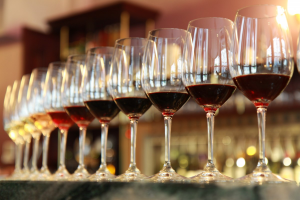There are some wineries that don’t offer you a lot of choice. In Bordeaux, for example, custom, pride and winemaking laws mean that there are only one or two wines to try, the second label and the grand vin. On the other hand, there are many (too many, in our opinion) vineyards that are raising all sorts of grapes, whether they are well accommodated to the terroir or not. While there are some exceptions, wineries that grow Cabernet Sauvignon, Grenache, Pinot Noir, Chardonnay and Sauvignon Blanc all on their 20 acres can’t possibly make them all into good wines. And many wineries that are more restrained in the types of wine they make have two or more tasting lists at different levels of price and quality.
Photo courtesy of DrinkPreneur
The best idea is to restrict yourself to drinking the best wines available. But maybe you don’t know what’s the best, or you don’t feel like spending a small fortune for a small pour, no matter how great the wine. Here’s a few tips on dealing with overwhelming choices.
- Don’t try to taste everything. For one thing, you’re almost guaranteed to get a lot of wine you don’t like. For another, it’s not legal for a winery to pour you that much wine. Especially if you’ve been elsewhere beforehand, no matter how much you think you can handle, you probably can’t. And even if you can, you shouldn’t. Have a nice day in the country, not in a police station or worse, a hospital.
- Don’t ask what’s most popular. There are a lot of factors that determine popularity. In many case it’s price without regard to quality. Or you may be in Wine Country in hot summer weather and the most popular is an ice-cold quaff, which is no help to you if you are in the mood for a subtle Pinot Noir.
- Look at the prices. There is often – but not always – a correlation between the highest priced bottles and the best wines. If you don’t know much about the production of a particular winery, it’s not a bad idea to limit your tastes to the bottom of the list. (The most expensive are always on the bottom. ) But you might also find yourself with a highly alcoholic, over-the-top wine that the winemaker was just experimenting with.
- Ask what’s the best on the list. In many cases, they server can’t or won’t answer directly. If he or she is part of the ownership family, it may be like asking “which is your favorite child?” But if your server is an educator, he or she will answer you by asking, “tell me about what kinds of wine you like”. So if you say, for example, you like big, fruity wines with a long finish, the server may reach for the Cab and the Zin and leave the other wines below the bar. Or you could do it the other way round. Describe what you’d like to taste and let the server find it for you.
- Build your own tasting list. Maybe you like the whites on the less expensive list and the reds on the reserve list. Tell your server that. If that person has any sense at all, he or she will seek to have a happy customer and give you what you want. You may pay a little more than you would otherwise for the cheaper wines, but you’re more likely to go away happy.
